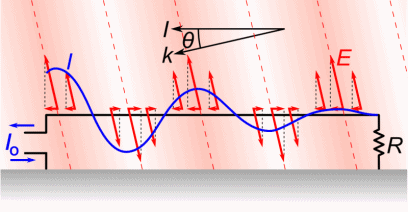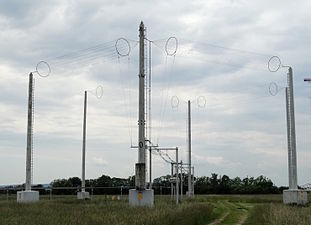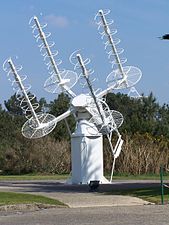Antenna Types – Traveling wave Antenna
February 4, 2019
Antenna Types – Traveling wave Antenna

Animation showing a Beverage antenna .

Quadrant antenna, similar to rhombic, at an Austrian shortwave broadcast station. Radiates horizontal beam at 5-9 MHz, 100 kW

Array of four axial-mode helical antennas used for satellite tracking, France
Unlike the above antennas, traveling wave antennas are not resonant so they have inherently broad bandwidth. They are typically wire antennas that are multiple wavelengths long, through which the voltage and current waves travel in one direction, instead of bouncing back and forth to form standing waves as in resonant antennas. They have linear polarization (except for the helical antenna). Unidirectional traveling wave antennas are terminated by a resistor at one end equal to the antenna’s characteristic resistance, to absorb the waves from one direction. This makes them inefficient as transmitting antennas.
Beverage – Simplest unidirectional traveling wave antenna. Consists of a straight wire one to several wavelengths long, suspended near the ground, connected to the receiver at one end and terminated by a resistor equal to its characteristic impedance, 400–800 Ω at the other end. Its radiation pattern has a main lobe at a shallow angle in the sky off the terminated end. It is used for reception of skywaves reflected off the ionosphere in long distance “skip” shortwave communication.
Rhombic – Consists of four equal wire sections shaped like a rhombus. It is fed by a balanced feedline at one of the acute corners, and the two sides are connected to a resistor equal to the characteristic resistance of the antenna at the other. It has a main lobe in a horizontal direction off the terminated end of the rhombus. Used for skywave communication on shortwave bands.
Leaky wave – Microwave antennas consisting of a waveguide or coaxial cable with a slot or apertures cut in it so it radiates continuously along its length.
Helical (axial mode) – Consists of a wire in the shape of a helix mounted above a reflecting screen. It radiates circularly polarized waves in a beam off the end, with a typical gain of 15 dBi. It is used at VHF and UHF frequencies where antenna sizes are feasible. Often used for satellite communication, which uses circular polarization because it is insensitive to the relative rotation on the beam axis. When a helical antenna has about 10 turns or more, each turn a full wavelength, then it is a form of traveling wave antenna. If it only has a few turns (or just one) and the turns’ totaled circumference is one or a few wavelengths, then it is some variety of a large loop antenna. When the totaled circumference of all the turns taken together is less than one wavelength, then the helix is a continuously-loaded monopole, called a “rubber ducky antenna”, or a “Slinky™” antenna, or a “broomstick” antenna.
